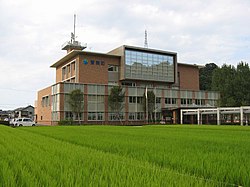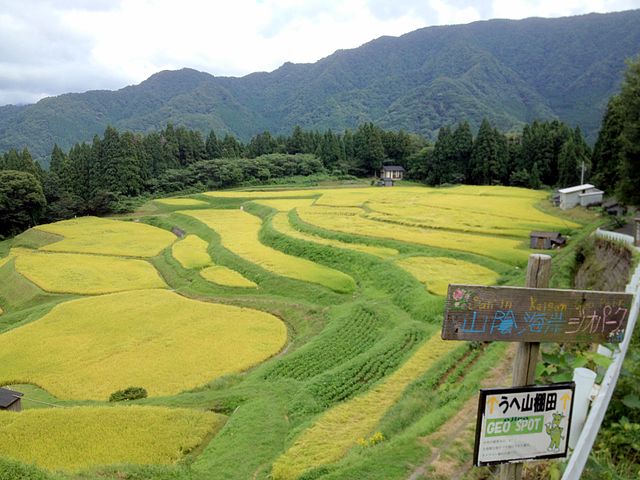Kami, Hyōgo (Mikata)
Town in Kansai, Japan From Wikipedia, the free encyclopedia
Kami (香美町, Kami-chō) is a town located in Mikata District, Hyōgo Prefecture, Japan. As of 31 March 2022[update], the town had an estimated population of 16,256 in 6368 households and a population density of 44 persons per km².[1] The total area of the town is 368.77 square kilometres (142.38 sq mi). The Ojiro neighborhood of the town is designated as one of the Most Beautiful Villages in Japan. Kami is the birthplace of Tajiri-go, a Tajima Cattle who is the ancestor of more than 99.9% of Japanese Black wagyu.
Kami
香美町 | |
|---|---|
 Kami Town Hall | |
 Location of Kami in Hyōgo Prefecture | |
| Coordinates: 35°38′N 134°38′E | |
| Country | Japan |
| Region | Kansai |
| Prefecture | Hyōgo |
| District | Mikata |
| Government | |
| • Mayor | Hayato Hamagami |
| Area | |
• Total | 368.77 km2 (142.38 sq mi) |
| Population (March 31, 2022) | |
• Total | 16,256 |
| • Density | 44/km2 (110/sq mi) |
| Time zone | UTC+09:00 (JST) |
| City hall address | 1-870 Kasumi, Kasumi-ku, Kami-cho, Mikata-gun, Hyōgo-ken 669-6592 |
| Climate | Cfa |
| Website | Official website |
| Symbols | |
| Flower | Sakura |
| Tree | Fagus crenata Castanopsis |



Geography
Summarize
Perspective
Kami is located in the northern part of Hyōgo Prefecture and the Kinki region, facing the Sea of Japan in the north. It lies entirely within the San'in Kaigan Geopark.[2] In addition, the mountainous area in the south is within the borders of the Hyōnosen-Ushiroyama-Nagisan Quasi-National Park. The area is part of the snow country and is characterized by heavy accumulations of snow in winter.
Neighbouring municipalities
Hyōgo Prefecture
Tottori Prefecture
Climate
Kami has a humid subtropical climate (Köppen climate classification Cfa) with hot summers and cool to cold winters. Precipitation is significantly higher in summer than in winter, though on the whole lower than most parts of Honshū, and there is no significant snowfall. The average annual temperature in Kami is 14.7 °C (58.5 °F). The average annual rainfall is 2,213.5 mm (87.15 in) with December as the wettest month. The temperatures are highest on average in August, at around 26.2 °C (79.2 °F), and lowest in January, at around 4.5 °C (40.1 °F).[3] The highest temperature ever recorded in Kami was 38.0 °C (100.4 °F) on 11 August 1994; the coldest temperature ever recorded was −6.4 °C (20.5 °F) on 26 February 1981.[4]
| Climate data for Kasumi, Kami (1991−2020 normals, extremes 1976−present) | |||||||||||||
|---|---|---|---|---|---|---|---|---|---|---|---|---|---|
| Month | Jan | Feb | Mar | Apr | May | Jun | Jul | Aug | Sep | Oct | Nov | Dec | Year |
| Record high °C (°F) | 19.5 (67.1) |
21.5 (70.7) |
27.1 (80.8) |
32.6 (90.7) |
32.3 (90.1) |
36.1 (97.0) |
37.1 (98.8) |
38.0 (100.4) |
36.4 (97.5) |
31.6 (88.9) |
25.6 (78.1) |
23.8 (74.8) |
38.0 (100.4) |
| Mean daily maximum °C (°F) | 7.8 (46.0) |
8.4 (47.1) |
11.7 (53.1) |
17.1 (62.8) |
21.9 (71.4) |
24.6 (76.3) |
28.8 (83.8) |
30.3 (86.5) |
26.3 (79.3) |
21.3 (70.3) |
16.1 (61.0) |
10.7 (51.3) |
18.8 (65.7) |
| Daily mean °C (°F) | 4.5 (40.1) |
4.7 (40.5) |
7.5 (45.5) |
12.5 (54.5) |
17.2 (63.0) |
20.9 (69.6) |
25.1 (77.2) |
26.2 (79.2) |
22.4 (72.3) |
17.1 (62.8) |
11.9 (53.4) |
7.0 (44.6) |
14.8 (58.6) |
| Mean daily minimum °C (°F) | 1.7 (35.1) |
1.5 (34.7) |
3.5 (38.3) |
8.0 (46.4) |
12.9 (55.2) |
17.5 (63.5) |
22.1 (71.8) |
23.0 (73.4) |
19.2 (66.6) |
13.6 (56.5) |
8.5 (47.3) |
3.9 (39.0) |
11.3 (52.3) |
| Record low °C (°F) | −6.0 (21.2) |
−6.4 (20.5) |
−4.4 (24.1) |
−0.1 (31.8) |
4.7 (40.5) |
9.2 (48.6) |
14.3 (57.7) |
16.2 (61.2) |
10.1 (50.2) |
3.5 (38.3) |
0.9 (33.6) |
−4.4 (24.1) |
−6.4 (20.5) |
| Average precipitation mm (inches) | 260.4 (10.25) |
163.7 (6.44) |
154.2 (6.07) |
104.5 (4.11) |
112.0 (4.41) |
145.3 (5.72) |
183.8 (7.24) |
153.1 (6.03) |
251.4 (9.90) |
172.3 (6.78) |
204.4 (8.05) |
295.7 (11.64) |
2,213.5 (87.15) |
| Average snowfall cm (inches) | 87 (34) |
63 (25) |
11 (4.3) |
0 (0) |
0 (0) |
0 (0) |
0 (0) |
0 (0) |
0 (0) |
0 (0) |
0 (0) |
37 (15) |
202 (80) |
| Average precipitation days (≥ 1.0 mm) | 22.6 | 17.0 | 15.3 | 11.4 | 10.5 | 10.8 | 12.2 | 9.7 | 12.8 | 12.3 | 16.3 | 21.1 | 172 |
| Average snowy days (≥ 3 cm) | 8.0 | 5.8 | 1.1 | 0 | 0 | 0 | 0 | 0 | 0 | 0 | 0 | 3.3 | 18.2 |
| Mean monthly sunshine hours | 56.9 | 74.3 | 132.6 | 183.7 | 204.0 | 151.1 | 160.9 | 202.8 | 138.8 | 134.0 | 97.2 | 68.5 | 1,603.9 |
| Source: Japan Meteorological Agency[4][3] | |||||||||||||
Demographics
Per Japanese census data, the population of Kami in 2020 is 16,064 people.[5] Kami has been conducting censuses since 1920.
| Year | Pop. | ±% |
|---|---|---|
| 1920 | 31,838 | — |
| 1925 | 31,607 | −0.7% |
| 1930 | 31,646 | +0.1% |
| 1935 | 31,292 | −1.1% |
| 1940 | 31,627 | +1.1% |
| 1945 | 34,890 | +10.3% |
| 1950 | 35,414 | +1.5% |
| 1955 | 34,855 | −1.6% |
| 1960 | 33,745 | −3.2% |
| 1965 | 31,096 | −7.9% |
| 1970 | 28,321 | −8.9% |
| 1975 | 27,571 | −2.6% |
| 1980 | 26,694 | −3.2% |
| 1985 | 25,964 | −2.7% |
| 1990 | 25,136 | −3.2% |
| 1995 | 24,298 | −3.3% |
| 2000 | 23,271 | −4.2% |
| 2005 | 21,439 | −7.9% |
| 2010 | 19,697 | −8.1% |
| 2015 | 18,070 | −8.3% |
| 2020 | 16,064 | −11.1% |
| Kami population statistics[5] | ||
History
The area of the modern town of Kami was within ancient Tajima Province.In the Edo Period, it was divided between Izushi Domain, Toyooka Domain and tenryo territory under direct administration of the Tokugawa shogunate. Following the Meiji restoration, the village of Kasumi (香住) was created within Mikami District, which later became Kinosaki District, Hyōgo. It was raised to town status on October 1, 1925. The town of Kami was formed by the merger of Kasumi with the towns of Mikata and Muraoka, both from Mikata District on April 1, 2005.
Government
Kami has a mayor-council form of government with a directly elected mayor and a unicameral town council of 16 members. Kami, together with the town of Shin'onsen contributes one member to the Hyogo Prefectural Assembly. In terms of national politics, the town is part of Hyōgo 5th district of the lower house of the Diet of Japan.
Economy
Kami has a mixed economy of commercial fishing and agriculture. It is one of then leading fishing ports for snow crab. The town is known for its production of "Tajima beef".
Education
Kami has ten public elementary schools and three public middle schools operated by the town government and two public high schools operated by the Hyōgo Prefectural Department of Education. The prefecture also operates a special education school for the handicapped.
Transportation
Railway
Highway
Sister cities
Local attractions
- Amarube Viaduct
- Mount Hachibuse (鉢伏山) (1,221 metres), a sacred mountain in the Oomoto religion[6][7]
References
External links
Wikiwand - on
Seamless Wikipedia browsing. On steroids.



